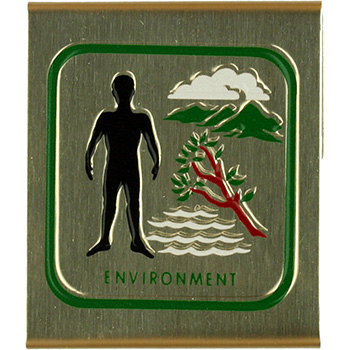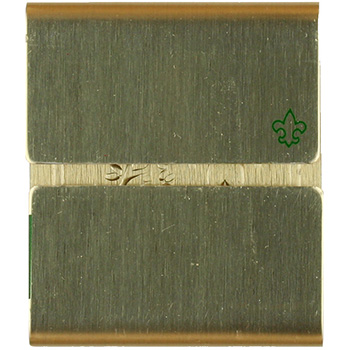
Fig. 1: SA-03-Enviro-Front
- Metal: Aluminum

Fig. 2: SA-03-Enviro-Reverse
- Reverse relief of front image, fdl on back
Item Name: Environment 1979 - 1989
Item ID: SA-03-Enviro
Collector Rating: 1
Requirements June 1972 – February 1979
1. Explain how animals (mammals, birds, fish, reptiles, insects) depend upon plants. In the outdoors, find and name 10 different kinds of wild animals or signs of them. Describe the environment where each was found.
2. Explain the relationship of plant life with the environment in which it grows. Tell the importance of plants to man. In the outdoors, find and name 10 different kinds of plants. Describe where each was found.
3. Do two of the following:
a. Make a closed terrarium that includes animals. Describe how you made it. Tell what you saw happen for a month.
b. Make an aquarium that has plants and animals. Describe how you made it. Tell what you saw happen for a month.
c. Keep a daily weather record for your neighborhood for a month. Include rainfall, sunshine, days with smog, temperature, wind speed and direction, and humidity. Tell how the weather affects you and your environment.
d. See and name 10 kinds of wild birds. Tell what each was doing when you saw it.
e. Grow a plant cutting in a plastic bag. Describe what you saw and learned.
4. Do one of the following:
a. Make a display of at least 20 newspaper and magazine clippings on national or local environmental problems.
b. Help an adult group with one of its ecology projects.
c. Name the major kinds of pollution in your town. Report one cause.
d. Report on the study of a 10-foot-square plot that has plants you can see. List the plants and animals you found.
Requirements February 1979 – August 1982
1. a. Tell what is meant by environment.
b. Describe how plant life, animal life, and environment relate to each other.
c. Explain the oxygen cycle.
d. Explain the water cycle.
2. Tell how sun, air, water, soil, minerals, plants, and animals produce food used by man.
3. a. Make a 3-hour exploration of a forest, field, park, wetland, lake shore, ocean shore, or desert. Make a list of plants and animal life you recognize.
b. In the outdoors, spot and name 10 wild animals by sight or sign (mammals, birds, fish, reptiles, mollusks).
c. In the outdoors, spot and name 10 wild plants.
d. Know how to identify poison ivy, poison oak, and poison sumac.
4. Do one:
a. Study a plot of ground, 1 m2(10 sq.ft.). Report on the plants and animals you fine.
b. Make a closed terrarium that includes animals. OR make an aquarium that includes both plants and animals.
c. Keep a daily weather record for least 2 weeks. Tell how weather affects the environment.
5. Display at least six newspaper or magazine clippings on environment problems.
Requirements August 1982 – February 1989
1. a. Tell what is meant by environment.
b. Describe how plant life, animal life, and environment relate to each other.
c. Explain the oxygen cycle.
d. Explain the water cycle.
2. Tell how sun, air, water, soil, minerals, plants, and animals produce food used by man.
3. a. Make a 3-hour exploration of a forest, field, park, wetland, lake shore, ocean shore, or desert. Make a list of plants and animal life you recognize.
b. In the outdoors, spot and name 10 wild animals by sight or sign (mammals, birds, fish, reptiles, mollusks).
c. In the outdoors, spot and name 10 wild plants.
4. Do one:
a. Study a plot of ground, 1 m2(10 sq.ft.). Report on the plants and animals you fine.
b. Make a closed terrarium that includes animals. OR make an aquarium that includes both plants and animals.
c. Keep a daily weather record for least 2 weeks. Tell how weather affects the environment.
5. Display at least six newspaper or magazine clippings on environment problems.
